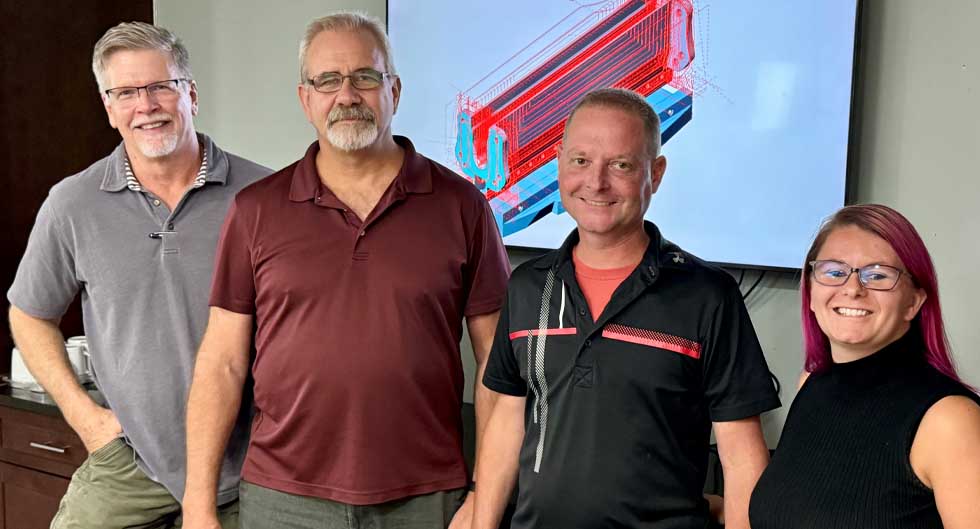Creatively Using Fixturing and Programming To Beat The Competition To Market
Getting to market first with a great product is a winning strategy. But in Compass Precision’s world, doing this with geometrically complicated parts is tough. Having plenty of 5-axis mills, with their inherent ability to reduce set-ups, helps considerably. However, this alone is seldom enough.
Earlier this year, one of R&D Machine’s space customers presented it with a challenge. This customer needed someone to machine two brand new parts for a new rocket design. Both parts were about 18 inches long and shaped like a channel on one side or both, with a maximum height-to-width ratio of an incredible 40-to-1. Other shops quoted lead-times of 12-15 weeks, citing the need to make each part in multiple operations, even when using 5-axis mills. Then, one of the customer’s engineers remembered work that R&D Machine had done on an earlier project. He called Justin Kovscek, R&D’s Vice President & General Manager (pictured above, second from right), and asked for help. This is what happened, as described by Justin:
“The engineer explained to me, in no uncertain terms, that his company needed twelve pieces each of these two parts NOW and simply could not wait 12-15 weeks. Accepting this delivery time would delay the launch of this new rocket and damage the company’s reputation. And he needed our best proposal within 24 hours.
We analyzed 3-D models of the parts and quickly realized the problem. Each part had a deep channel on one side or both, with walls extending 3-4 inches from the surface of the component. But the problem was the wall thickness of these channels, a mere 0.100 inch wide. The conventional, and safe, way to machine this difficult geometry would be to divide the work into multiple operations, using fixturing specifically designed for each op. Amongst ourselves, we agreed that this approach would require a lead-time of 12-15 weeks, even for the best shops, just as the customer engineer told us.
At that point, most of us figured we were dead in the water. But to give up easily is not the R&D way, nor the Compass way. So we brainstormed for a while, knowing that we only had a few hours to respond to the customer. Then an idea hit us. What if we took the tried-and-true, one-and-done concept to an extreme? This would require the development of extremely sophisticated fixturing because we would need to reach virtually all final surfaces in one operation. In addition, the CNC programming required would be much more complicated than needed for the conventional, multi-operation approach.
After we batted the pros and cons around, I took a vote. In the room were Tony Cattery (R&D Machine Programmer Engineer, pictured above left), Thom Amend (Production Manager, second from left above), Kat Pennison (Operations Manager, right above), and me. We all wanted to quote the project assuming doing each part in one op, plus as third op to machine the matching holes required to hold these two parts together. And we agreed that we could deliver both parts, 12 of each, in 6 weeks.
The customer’s engineer was thrilled. The PO arrived about 24 hours after our quote was submitted. We used the first week to order material, design and manufacture the fixtures, and create the CNC programs. Both parts were to be made from 7050 aluminum, about 80 pounds of starting material for the first part (final part weight 11 pounds) and 40 pounds of material for the second part (final part weight 8 pounds).
We started Op 1 within an hour of receiving material using our Haas VF-6 with 5-axis capabilities, the only machine in our shop large enough for these components. Since R&D Machine’s Oldsmar facility normally runs two shifts a day anyway, we were able to continue cutting chips for about 16 hours per day. We finished Op 1 on the first part halfway through the third week ARO, then immediately moved on to Op 1 with the second, slightly larger part. This operation was completed about halfway through the fifth week, allowing us the rest of this week to complete the final machining operation involving both parts. At the beginning of the sixth week ARO, we send the parts out for chromate surface treatment. At the end of that week, we got all twelve parts back from this outside vendor, completed final inspection, and shipped the parts to the customer.
I will have to admit it was touch-and-go for a while. Despite the confidence we all displayed in our decision meeting, none of us had ever done parts like these using this approach. But it worked. We quickly learned that the customer’s incoming inspection came off without a hitch. R&D Machine had accomplished what it promised and achieved a delivery time 50% or less than any competing shop had offered.
Since we shipped these parts, R&D has since received numerous additional orders from this customer. And they tell us there will be plenty more.”
For more information about this project, please contact Justin Kovscek at [email protected]. Or, reach out to Jim Miller, Compass’s VP of Sales, at [email protected] to inquire about using Compass’s resources for other challenging machining or fabrication projects.


